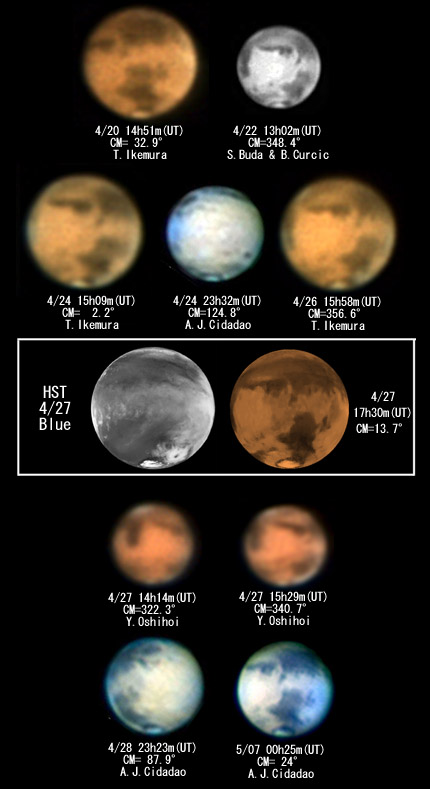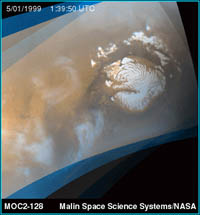Ground-based observations of Polar Cyclone on Mars in late April, 1999
Yuichi Iga
The Association of Lunar and Planetary Observers of Japan(ALPO-Japan)
May 25, 1999
|
Hubble discovered Martian polar storm in blue light(410nm) on April 27, 1999. This storm is located near 65 deg. N latitude and 85 deg. W longitude, and is more than 1600km across.
This report shows the tracking of this storm from ground-based mars observations that are ours in Japan and MarsWatch web pages(http://www.astroleague.org/marswatch/). In late April, the longitude of this storm could not be seen in America. It was the following member that could observe it in this time; Antonio Jose Cidadao(Portugal), Stefan Buda & Bratislav Curcic(Australia), Toshihiko Ikemura(Japan) and Yukio Oshihoi(Japan). The figure shows the images of this storm in time of the order.

It seems that the cloud of this storm has been clearly found only T.Ikemura's and Y.Oshihoi's images in Japan. As for the first observation, the cloud of this storm can be seen with T.Ikemura's image on April 24 at the west rim(near south-west of north polar cap). But the cloud near 85 deg. W longitude(near south-east of north polar cap) can not be seen with A.J.Cidadao's image on the same day. This storm can be also seen with T.Ikemura's image on April 26 at the same location, and it seems that the cloud is expanded toward east. Also the storm can be seen with Y.Oshihoi's image on April 27, and the Hubble observed the colossal polar cyclone after this image. But this can not be seen with A.J.Cidadao's image on April 28, although the cloud will be located at southward of north polar cap. Also the cloud that will be located at west can not be seen with A.J.Cidadao's image on May 7. Unfortunately we could not be observed this location of mars since April 28 by the reason of bad condition and no visible longitude. As this storm can not be seen before April 24(T.Ikemura on April 20, S.Buda & B.Curcic on April 22), it seems that this storm can be seen by ground-based observations from April 24 to April 27 in short term. However, it seems that this storm can be seen at the location of west rim(daybreak on mars), and can be difficult to see at the location of center when the altitude of the sun became big(daytime on mars).
|
 ALPO-Japan@
ALPO-Japan@ Mars Section
Mars Section
 NASA Mars Global Surveyor spacecraft, in orbit around the red planet, captured images(AnimatedGIF, 1.8MB) of north polar region from April 30 to May 4.
NASA Mars Global Surveyor spacecraft, in orbit around the red planet, captured images(AnimatedGIF, 1.8MB) of north polar region from April 30 to May 4.